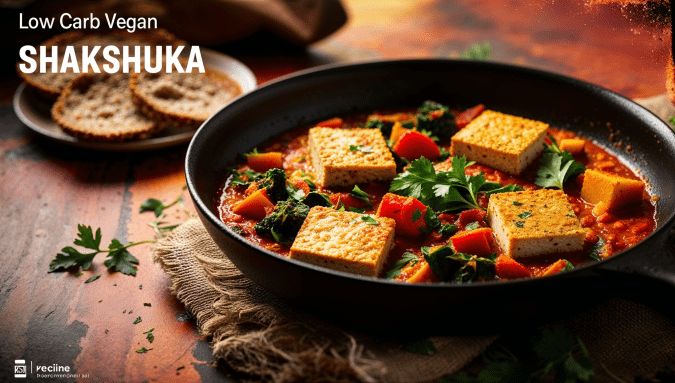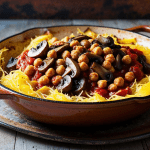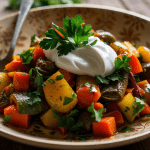This Low Carb Vegan Shakshuka is a delicious, egg-free adaptation of the traditional North African dish. It’s perfect for those following a vegan or keto diet, featuring a rich tomato and vegetable base with spices that create a flavorful meal.
Ingredients
- 2 tbsp extra-virgin olive oil
- 1/2 small onion, chopped (about 35g)
- 1/2 small bell pepper (yellow, orange, or red), cored, seeded, and chopped (about 35g)
- 1/4 tsp salt
- 2 tsp minced garlic
- 2 tsp smoked paprika
- 1 tsp ground cumin
- 1/2 (14.5 oz) can diced tomatoes with juice
- 1 medium zucchini, grated (about 200g)
- Red pepper flakes, to taste
- Ground black pepper, for garnish
- Paprika, for garnish
- Fresh parsley, chopped for garnish
Instructions
- Heat the Oil: In a medium frying pan over medium-low heat, add the olive oil.
- Cook Vegetables: Add the chopped onion and bell pepper along with the salt. Cook while stirring occasionally until soft, about 5 minutes.
- Add Spices: Stir in the minced garlic, smoked paprika, and ground cumin. Cook for an additional minute until fragrant.
- Combine Ingredients: Add the diced tomatoes and grated zucchini to the pan. Stir well to combine all ingredients.
- Simmer: Cover the pan and let it simmer for about 15 minutes until the vegetables are softened. If necessary, add a little water if the mixture becomes too dry.
- Season: Adjust seasoning with red pepper flakes, salt, and pepper to taste.
- Serve: Garnish with ground black pepper, paprika, and fresh parsley before serving.
Notes
- For added protein, consider using homemade plant-based “egg” cups made from lupin flour or tofu as a substitute for eggs.
- This dish can be stored in a sealed container in the refrigerator for up to three days and can be enjoyed cold or reheated.
- The total carbohydrate content is approximately 10.5g, with 3g of fiber, resulting in about 7.5g of net carbs per serving.
This recipe is versatile; feel free to adjust the spices or add other low-carb vegetables based on your preferences! Enjoy your healthy and flavorful Low Carb Vegan Shakshuka!
Creative Protein Substitutes for Low Carb Vegan Shakshuka
- Tofu: Firm tofu can be crumbled or sliced to mimic the texture of eggs. It absorbs flavors well and can be seasoned to enhance taste.
- Lupin Flour Egg Cups: These are made from lupin flour mixed with water, creating a batter that resembles scrambled eggs when cooked. They can be baked or pan-fried before adding to shakshuka.
- Store-bought Egg Replacers: Products like Just Egg provide a convenient option. They can be poured directly into the shakshuka and cooked until set.
- Chickpea Flour Scramble: A mixture of chickpea flour and water can be seasoned and cooked similarly to scrambled eggs, offering a high-protein alternative.
How to Make Homemade Plant-Based “Egg” Cups
To make homemade plant-based “egg” cups using lupin flour:
Ingredients
- 1 cup lupin flour
- 1 cup water
- Salt and spices (to taste)
Instructions
- Mix Ingredients: In a bowl, combine lupin flour, water, salt, and any desired spices (like turmeric for color).
- Cook: Heat a non-stick skillet over medium heat and pour in the mixture, spreading it evenly.
- Fry: Cook for about 3-4 minutes on each side until golden brown and firm.
- Serve: Cut into pieces or crumble to use in shakshuka.
Best Low-Carb Vegetables for Shakshuka
- Zucchini: Low in carbs and adds moisture and texture.
- Bell Peppers: Provide sweetness and flavor while remaining low in carbohydrates.
- Spinach or Kale: These leafy greens are nutrient-dense and low in carbs, adding color and health benefits.
- Mushrooms: Add umami flavor while being low in calories and carbs.
Alternative Oils for Cooking Shakshuka
You can use various oils for cooking shakshuka, including:
- Coconut Oil: Adds a subtle sweetness and is suitable for high-heat cooking.
- Avocado Oil: Has a high smoke point and a neutral flavor, making it versatile.
- Grapeseed Oil: A light oil that works well for sautéing without altering the dish’s flavors.
Adjusting the Spice Level in Low Carb Vegan Shakshuka
To adjust the spice level:
- Increase Heat: Add more red pepper flakes or diced fresh chili peppers to increase spiciness.
- Reduce Heat: Decrease the amount of spicy ingredients or add more sweet vegetables like bell peppers or zucchini to balance the heat.
- Taste as You Go: Start with small amounts of spices, taste the mixture, and gradually add more until you reach your desired level of heat.












